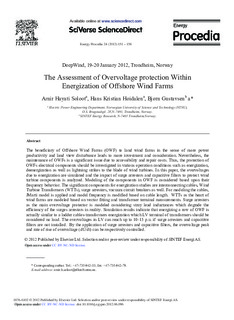| dc.contributor.author | Soloot, Amir Hayati | |
| dc.contributor.author | Høidalen, Hans Kristian | |
| dc.contributor.author | Gustavsen, Bjørn Alfred | |
| dc.date.accessioned | 2017-12-21T07:49:46Z | |
| dc.date.available | 2017-12-21T07:49:46Z | |
| dc.date.created | 2012-08-15T14:39:39Z | |
| dc.date.issued | 2012 | |
| dc.identifier.citation | Energy Procedia. 2012, 24 151-158. | nb_NO |
| dc.identifier.issn | 1876-6102 | |
| dc.identifier.uri | http://hdl.handle.net/11250/2473369 | |
| dc.description.abstract | The beneficiary of Offshore Wind Farms (OWF) to land wind farms in the sense of more power productivity and land view disturbance leads to more investment and consideration. Nevertheless, the maintenance of OWFs is a significant issue due to accessibility and repair costs. Thus, the protection of OWFs electrical components should be investigated in various operation conditions such as energization, deenergization as well as lightning strikes to the blade of wind turbines. In this paper, the overvoltages due to energization are simulated and the impact of surge arresters and capacitive filters to protect wind turbine components is analyzed. Modeling of the components in OWF is considered based upon their frequency behavior. The significant components for energization studies are interconnecting cables, Wind Turbine Transformers (WTTs), surge arresters, vacuum circuit breakers as well. For modeling the cables, JMarti model is applied and model frequency is modified based on cable length. WTTs as the heart of wind farms are modeled based on vector fitting and transformer terminal measurements. Surge arresters as the main overvoltage protector is modeled considering stray lead inductances which degrade the efficiency of the surges arresters in reality. Simulation results indicate that energizing a row of OWF is actually similar to a ladder cables-transformers energization which LV terminal of transformers should be considered no load. The overvoltages in LV can reach up to 10-15 p.u. if surge arresters and capacitive filters are not installed. By the application of surge arresters and capacitive filters, the overvoltage peak and rate of rise of overvoltage (dU/dt) can be respectively controlled. Copyright © 2012 Published by Elsevier Ltd. | nb_NO |
| dc.language.iso | eng | nb_NO |
| dc.publisher | Elsevier | nb_NO |
| dc.rights | Attribution-NonCommercial-NoDerivatives 4.0 Internasjonal | * |
| dc.rights.uri | http://creativecommons.org/licenses/by-nc-nd/4.0/deed.no | * |
| dc.title | The Assessment of Overvoltage Protection Within Energization of Offshore Wind Farms | nb_NO |
| dc.type | Journal article | nb_NO |
| dc.type | Peer reviewed | nb_NO |
| dc.description.version | publishedVersion | nb_NO |
| dc.source.pagenumber | 151-158 | nb_NO |
| dc.source.volume | 24 | nb_NO |
| dc.source.journal | Energy Procedia | nb_NO |
| dc.identifier.doi | 10.1016/j.egypro.2012.06.096 | |
| dc.identifier.cristin | 938857 | |
| dc.relation.project | Norges forskningsråd: 193823 | nb_NO |
| dc.description.localcode | © 2012 Published by Elsevier Ltd. Open access under CC BY-NC-ND license (https://creativecommons.org/licenses/by-nc-nd/3.0/) | nb_NO |
| cristin.unitcode | 194,63,20,0 | |
| cristin.unitname | Institutt for elkraftteknikk | |
| cristin.ispublished | true | |
| cristin.fulltext | original | |
| cristin.qualitycode | 1 | |

